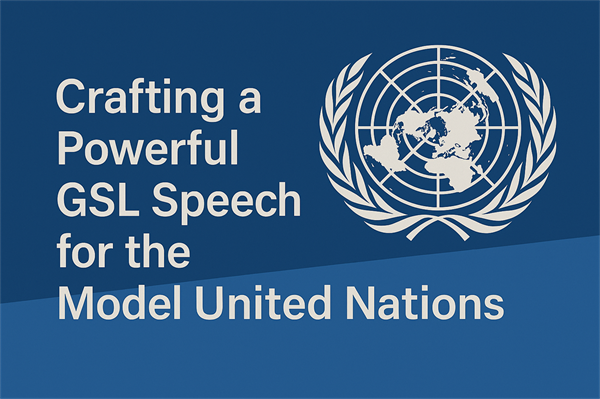Understanding Model United Nations (MUN) Procedure
Model United Nations (MUN) is an academic simulation of the United Nations that allows students to experience diplomacy, international relations, and policy-making firsthand. Participants, known as delegates, represent different countries and work together to solve global issues through discussion, debate, and negotiation. To ensure a structured and professional experience, every MUN follows a defined procedure. Understanding this procedure is essential for every delegate to participate effectively and confidently.
1. The Basics of MUN Procedure
In MUN, participants follow parliamentary-style rules of debate. These rules mirror the formalities of the real United Nations. The procedure helps maintain order, fairness, and productivity during discussions. The major components of an MUN procedure include the Roll Call, Setting the Agenda, Debate Sessions, Motions, Draft Resolutions, and Voting.
Every MUN committee is moderated by a Chairperson or Executive Board who ensures that the debate proceeds smoothly according to these rules.
2. Roll Call and Setting the Agenda
The MUN session begins with a Roll Call, where the Chair calls out the names of participating countries. Delegates respond with “Present” or “Present and Voting.”
-
Saying “Present” means the delegate may abstain during voting.
-
Saying “Present and Voting” means the delegate must vote either in favor or against resolutions.
After the roll call, delegates move to Setting the Agenda. This is where they decide which issue or topic will be discussed first if the committee has multiple topics. Delegates propose motions to set the agenda, and voting decides the order of discussion.
3. Formal and Informal Debate
Once the agenda is set, the committee moves into the General Speakers’ List (GSL). Here, delegates deliver opening speeches outlining their country’s stance on the issue. The Chair maintains a time limit, usually between one and two minutes per speech.
After a few speeches, delegates can introduce motions to move into Moderated or Unmoderated Caucuses, which are more focused and interactive forms of debate.
-
Moderated Caucus: Delegates discuss a specific subtopic with timed speeches, moderated by the Chair. For example, a motion may be, “Motion for a 10-minute moderated caucus on renewable energy funding.”
-
Unmoderated Caucus: Also called a “lobbying session,” this is an informal break from formal debate where delegates move around the room, form alliances, and begin drafting resolutions together.
This combination of structured and unstructured discussions helps simulate real-world diplomacy.
4. Motions and Points
During debate, delegates can raise motions and points to control the flow of discussion or seek clarifications.
Common motions include:
-
Motion to open or close the General Speakers’ List
-
Motion for a moderated/unmoderated caucus
-
Motion to adjourn or suspend the meeting
Common points include:
-
Point of Personal Privilege: Raised when a delegate is uncomfortable (e.g., can’t hear the speaker).
-
Point of Parliamentary Inquiry: Asked when a delegate needs clarification on procedure.
-
Point of Order: Raised if a delegate believes the rules are being broken.
Understanding when and how to use motions and points is a key skill for effective participation.
5. Drafting Resolutions
After substantial debate and collaboration, delegates begin writing Draft Resolutions. These are formal documents proposing solutions to the discussed issue. Resolutions typically consist of two parts:
-
Preambulatory Clauses – describe the background and importance of the issue.
-
Operative Clauses – outline specific actions or solutions proposed by the committee.
A draft resolution needs a certain number of sponsors and signatories before being introduced to the committee. Sponsors are countries that actively write and support the resolution, while signatories merely agree it should be discussed.
During the Resolution Presentation, sponsors explain their draft to the committee, after which delegates debate, amend, and vote on it.
6. Amendments and Voting
Delegates can propose amendments to modify specific clauses in a draft resolution. There are two types:
-
Friendly Amendment: All sponsors agree to the change, so it is automatically added.
-
Unfriendly Amendment: Not all sponsors agree, so the committee must debate and vote on it.
Finally, the committee votes on the resolution. Depending on the rules, voting can be by show of placards or roll call. If the resolution passes with a majority, it becomes the official decision of the committee.
7. Etiquette and Professionalism
Professionalism is crucial in MUN. Delegates must always speak in third person (e.g., “The delegate of India believes...”), maintain diplomatic language, and show respect for differing opinions. Active listening, teamwork, and negotiation are more valuable than aggressive debate.
The ultimate goal of MUN is collaboration, not competition. The most successful delegates are those who build consensus and find creative, realistic solutions.
8. Why MUN Procedure Matters
The MUN procedure is not just a set of rules; it’s a framework for learning diplomacy, critical thinking, and communication. By following proper procedure, delegates learn how international organizations function in real life — how countries debate, negotiate, and compromise to solve global challenges.
Through MUN, participants gain valuable life skills: public speaking, research, negotiation, leadership, and teamwork. These abilities are essential for future leaders and global citizens.

Comments
Post a Comment